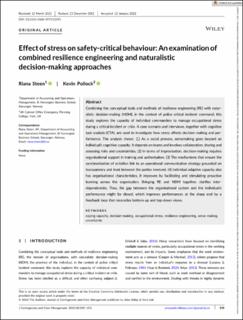Effect of Stress on Safety-critical Behaviour: An Examination of combined Resilience Engineering and Naturalistic Decision-making Approaches
Peer reviewed, Journal article
Published version
Permanent lenke
https://hdl.handle.net/11250/2978780Utgivelsesdato
2022Metadata
Vis full innførselSamlinger
- Scientific articles [2173]
Originalversjon
Journal of Contingencies and Crisis Management. 2022, volume 30, issue 3, p. 339-351. 10.1111/1468-5973.12393Sammendrag
Combining the conceptual tools and methods of resilience engineering (RE) with naturalistic decision-making (NDM), in the context of police critical incident command, this study explores the capacity of individual commanders to manage occupational stress during a critical incident or crisis. A case scenario and interviews, together with cognitive task analysis (CTA), are used to investigate how stress affects decision making and performance. The analysis shows: (1) As a social process, sensemaking goes beyond an individual's cognitive capacity. It depends on teams and involves collaboration, sharing and assessing risks and uncertainties. (2) In terms of improvisation, decision-making requires organisational support in training and authorisation. (3) The mechanisms that ensure the synchronisation of activities link to an operational communication strategy grounded on transparency and trust between the parties involved. (4) Individual adaptive capacity also has organisational characteristics. It improves by facilitating and stimulating proactive learning across the organisation. Bringing RE and NDM together, clarifies interdependencies. Thus, the gap between the organisational system and the individual's performance might be closed, which improves performances at the sharp end by a feedback loop that reconciles bottom-up and top-down views.
